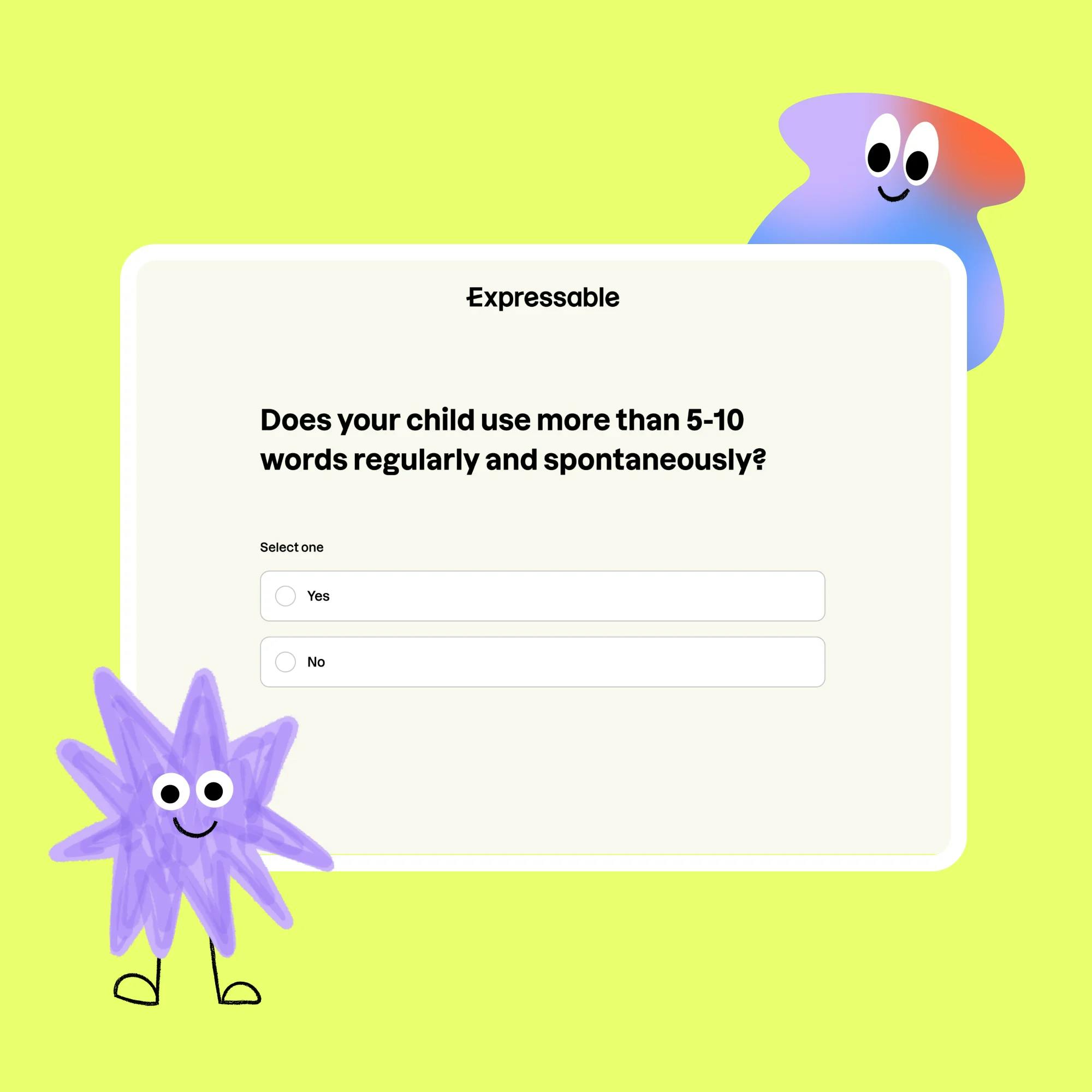
When to Seek Professional Help if Your Child Stutters
 Abby Barnes, M.S., CCC-SLP
Abby Barnes, M.S., CCC-SLP
Did you know that many kids stutter at some point in childhood? In fact, between 5% and 10% of all children will stutter, for a few weeks up to several years. This often happens between the ages of 2 and 6 years old, as kids are developing their language skills.
While about 75% of these children will naturally overcome their stutter with time, the remaining 25% may need speech therapy to help avoid stuttering into adulthood.
So how do you know if your child's stutter will persist, or if it's a temporary bump on the road to acquiring language skills? In other words, when is a stutter considered a "clinical stutter" that may need speech therapy? In this article, our experts help you understand the difference and when to consider a speech evaluation.
Support for children who stutter
Speech therapy helps kids who stutter boost their confidence and speak more freely. Find the right therapist for your child at Expressable.
 Get started
Get startedHow speech develops in children
When children begin to talk, speech errors are common. They may mispronounce certain speech sounds or words. Young toddlers may be hard to understand, especially by people who don't know them well. This is normal--rarely will a young child's speech be 100% accurate. It can take time for speech to develop and become more mature sounding.
Likewise, as children begin using longer phrases and sentences, occasional stuttering may occur. During times of significant vocabulary growth, children often stutter. This is likely due to the more complex motor planning needed for their tongue and lips to coordinate longer sentences.


What does stuttering sound like?
Here are some examples of different types of stuttering that you may hear in your child’s speech:
Repetitions: Repetitions are a type of disfluency, or speech interruption, in which a word, syllable, or sound is repeated more than three times. Here’s an example: “I w-w-w-w-w-w-want a snack.”
Prolongations: Prolongations happen when a sound is prolonged or held for an abnormally long period of time, such as, “I fffffffffffffffffound my shoe.”
Signs that a stutter is not a normal part of development
As we mentioned, stuttering can be a typical part of language development. However, if a stutter lasts longer than 3 to 6 months, this could be a sign that the stuttering has become a clinical issue. It may be time to seek a professional opinion from a speech therapist.
Here are some other signs that your child may be experiencing abnormal fluency, or smoothness of speech, and could benefit from a speech evaluation:
You notice repetitions, prolongations, or blocks (pausing of speech) in your child's everyday speech
Your child avoids talking or has a lack of confidence
Your child avoids saying certain words in order to prevent their stutter
Your child expresses concern about their speech
You notice abnormal body movements (eye blinking, jerky jaw movements, foot stomping, etc.) that happen while your child speaks
Your child gets out of breath while speaking
If you notice any of these signs, it's best to contact a speech therapist early on, before the stutter has time to progress.
If your child's speech is found to be typical during the evaluation, that’s great! It will put your mind at ease. But if their fluency is not typical, early intervention is recommended, since speech therapy can prevent stuttering from worsening and persisting. The sooner your child learns how to manage their stutter, the better!
Joseph's story
Discover how Joseph, a preteen who stutters, transformed his speech, confidence, and sense of control.
 Read Joseph's story
Read Joseph's storyWhat happens during a speech evaluation for stuttering?
First, your speech therapist will likely give you a case history form to fill out, or ask you questions about your child’s medical and developmental history. Be sure to mention if there is any family history of stuttering, since a child is more likely to stutter if a parent or sibling does.
The speech therapist will do an oral-motor evaluation to assess the strength and function of your child's oral muscles. This is done to rule out any physical or motor issues that could affect speech.
Your child will also likely be screened for articulation and language abilities. If the speech therapist feels it is appropriate, a formal evaluation for these clinical areas may be done. However, most of the testing will likely focus on speech fluency. The speech therapist will use a variety of techniques to test different aspects of the stutter. If your child is old enough to read, they may be asked to read a short story out loud in order to assess reading fluency. The therapist will then engage your child in conversation or ask them to tell a short story. This will assess speaking fluency. If your child is not reading yet, the therapist will likely obtain a couple of different speaking fluency samples.
After performing these tests, the speech therapist will count the number of stuttered syllables in each speech sample, as well as the total number of syllables spoken. This helps the therapist calculate the percentage of syllables stuttered. If this is done via a normative assessment, this numeric data can better explain where a child’s speech fluency skills fall when compared to children their same age.
While numeric data is important, the speech therapist will consider your child’s speech as a whole. Speech therapists are continually assessing a child’s speech during the entire evaluation.
Finally, the speech therapist will look for any secondary behaviors that could be present. Secondary behaviors are physical behaviors related to the stuttering. These can include eye blinks, abnormal jaw movements, foot stomping, clenching fists, etc. These behaviors are learned by the child over time as they attempt to avoid stuttering. Be sure to mention if you see any of these behaviors at home.
You can learn more about the evaluation process and Expressable's treatment approach in our stuttering treatment guide.

How can you help your child with their stutter?
If you think your child is stuttering, here are some simple things you can do to support them at home.
Give your child plenty of time when you're talking together. Don’t rush them.
Don’t react negatively to any stuttering you hear.
Don’t interrupt your child.
Let your child know how much you enjoy talking with them, and provide plenty of praise and encouragement.
Find a speech therapist who specializes in stuttering
At Expressable, we’ve helped hundreds of children who stutter learn to speak more smoothly and confidently. With online speech therapy at Expressable, your child will learn from their speech therapist during their session. But you’ll also be coached on how to support your child at home, between sessions—because kids learn best from the people they spend the most time with and love the most (that’s you!). You’ll also have access to our innovative online learning portal, full of videos, tips, and activities to help make at-home speech therapy practice even easier. Remember, more practice means more progress! Ready to get started? Click here to find a speech therapist for your child.
FAQs about when speech therapy is needed for a stutter
1 Is it ever normal for children to stutter?
Stuttering can be a normal part of speech development. Between 5% and 10% of children ages 2 to 6 years old will stutter. While about 75% of them will naturally overcome their stutter, the other 25% may need speech therapy to help avoid stuttering into adulthood.
2 How do you know if your child needs speech therapy for their stutter?
Your child might need speech therapy if they have repetitions, prolongations, or blocks in their everyday speech; if their stutter lasts longer than 6 months; or if they avoid talking because of their stutter. If you're not sure, you can take our free online screener to find out if an evaluation is recommended for your child.
3 How is a child diagnosed with a stutter?
In the evaluation, a speech therapist will assess the strength and function of your child's oral muscles, their articulation and language skills, and the percentage of stuttering in their speech. They will also talk with you and consider your child's medical history. Click here to get matched with a therapist and schedule an evaluation for your child.
How Expressable Can Help
Concerned your child isn't reaching age-expected milestones? Looking for communication support from a professional? Expressable is a national online speech therapy practice serving children and adults. We treat all major areas of communication and feeding, offer flexible hours including evenings and weekends, and accept most major health insurance plans. We’re proud to have earned more than 3,000 5-star reviews from our clients (4.9/5 average).
Our therapy model is centered on parent and caregiver involvement. Research proves that empowering caregivers to participate in their loved one’s therapy leads to better outcomes. That’s why we combine live, 1-on-1 speech therapy with personalized education and home practice activities for faster progress.
Communication is more than words. It’s how we share how we feel and show who we are. We’re here to help you or your child do just that.










